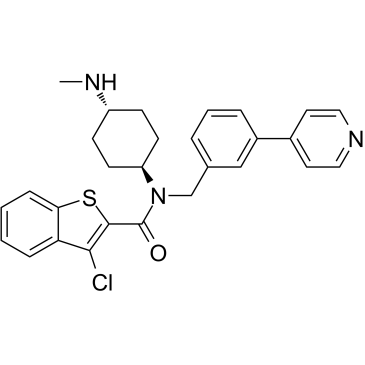| Cas No.: | 912545-86-9 |
| Chemical Name: | SAG (Smo agonist) free base |
| Synonyms: | SAG; SAG free base; SAG (Smo agonist); SAG (cyclopamine antagonist); |
| SMILES: | O=C(C1=C(Cl)C2=CC=CC=C2S1)N([C@H]3CC[C@H](NC)CC3)CC4=CC=CC(C5=CC=NC=C5)=C4 |
| Formula: | C28H28ClN3Os |
| M.Wt: | 490.06 |
| Sotrage: | 2 years -20°C Powder, 2 weeks4°C in DMSO,6 months-80°C in DMSO |
| Description: | SAG is a potent Smo receptor agonist which activates the Hedgehog signaling pathway with a Kd of 59 nM. |
| In Vivo: | In CD-1 mice, SAG (1.0 mM) or NELL-1 (600 μg/ml) alone results in increased bone formation at 4 and 8 weeks, but significantly greater bone formation with both components combined (SAG + NELL-1). The combination of the two compounds exhibits a significant increase in new bone formation, accompanied by increased defect vascularization[3]. SAG (15, 17, or 20 mg/kg, i.p.) induces pre-axial polydactyly prevalently. The highest SAG dose is effective in ca. 80% of the embryos and increased Gli1 and Gli2 mRNA expression in the limb bud, with Gli1 mRNA being the most upregulated[4]. |
| In Vitro: | SAG acts downstream of Ptch1 in the Hh pathway and counteracts cyclopamine inhibition of Smo. SAG induces firefly luciferase expression in Shh-LIGHT2 cells with an EC50 of 3 nM and then inhibits expression at higher concentrations. In Smo-expressing Cos-1 cells, SAG yields an apparent dissociation constant (KD) of 59 nM for the SAG/Smo complex[1]. SAG and purmorphamine verride the inhibitory effect of robotnikinin since Smo functions downstream of Shh/Ptc1[2]. |






















